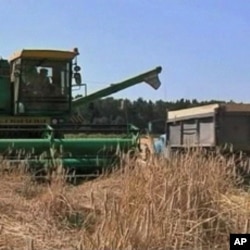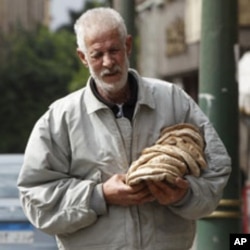In a year of protests in the Arab world, high food prices helped to make oppression, corruption and poverty under autocratic leaders even more intolerable.
“Prices are so expensive," said one protester about Egypt's leaders. " What shall we do right now? We have to stay until they are gone and give a chance to others who can satisfy our needs.”
Price spike
The political fires that burned across North Africa, many say, were kindled in Russia last summer. Extreme drought triggered wildfires and destroyed one-third of the country’s wheat harvest. Russia refused to export the rest of its harvest. Markets panicked and food prices shot up.
“Definitely, it is one of the causes of the Arab Spring,” says Shenggen Fan, director-general of the International Food Policy Research Institute.
In 2008, the last time global food prices spiked, Egypt was one of several countries hit by food riots and demonstrations.
Fan believes the return of high prices in 2011 offers some important lessons. "Food price hikes will come more often, and more frequent. So this is the first lesson we learned. Second, food prices obviously will remain very high.”
Food prices will remain high and volatile, Fan says, because demand for food is increasing and supply is not keeping up. This year the world population hit seven billion, with another two billion expected by mid-century. People in emerging economies like China are eating more meat, which requires more animal feed.
Feeding biofuel
But demand for food is just one factor, according to Cornell University economist Chris Barrett. “It’s also the diversion of food and feed to the production of biofuels.”
In the United States, 2011 was the first time more maize went to make ethanol fuel than to feed animals.
Meanwhile, the pace of farm productivity gains has been slowing, Barrett says.
“What we’re seeing right now is the bitter harvest of very poor investments in agriculture research over, really, the last 20 years.”
That means a few bouts of bad weather can cause serious disruptions in world food markets today. And those disruptions are becoming more likely with climate change.
Political realities
Farm ministers from the G20 leading and emerging economies met for the first time this year to discuss the crisis. In 2009, G8 leaders pledged $22 billion to developing-world agriculture. But not much came of the meeting, or the pledge, from countries with financial troubles of their own, Barrett says.
“The political realities of domestic troubles in the major economies are effectively choking off concerted public-sector response right now, which is a real concern.”
But while those domestic troubles continue, so do the forces pushing food prices up, says Fan, of the International Food Policy Research Institute.
“So if we do not invest in agriculture, do not invest in food production, we will continue to see tightening supply. We will continue to see high prices.”
The good news in this is that high prices always encourage farmers to grow more. A record harvest in 2011 is helping to temper food prices in many, though not all, regions of the world.
In Egypt, for example, food prices have continued to rise. Elsewhere, experts do not expect much downward movement in the cost of food. High and volatile food prices are in the forecast for 2012 and beyond.














